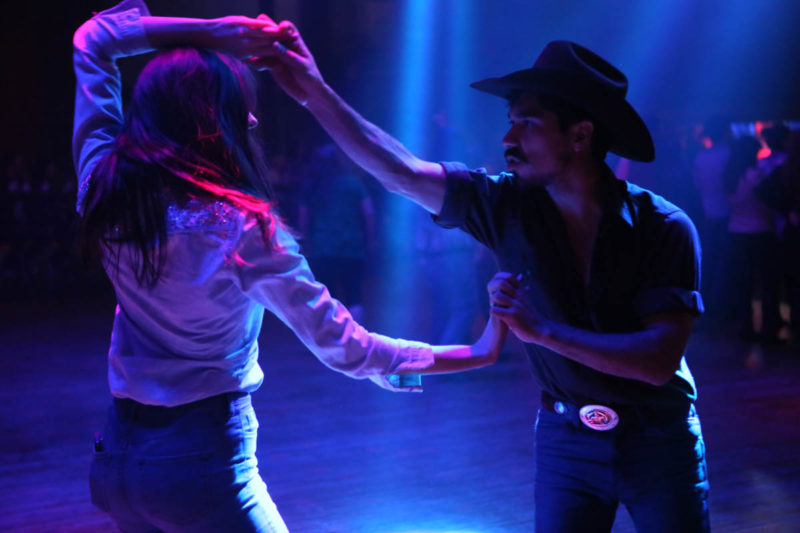Santiago Jiménez Jr. Fights to Keep Conjunto Alive
By Alvaro Céspedes
Photography By Kara Henderson
Reporting Texas

Santiago Jiménez Jr., 73, left, and Luis Almanza, 79, get together every Sunday at a San Antonio restaurant. Jimenez, a conjunto musician, performs there every week. Alvaro Céspedes/Reporting Texas
Santiago Jiménez Jr. walks into the small backstage room with a beer and an unlit cigarette in his right hand.
“If I don’t have a few beers before going on stage, I don’t feel as comfortable,” he admits in Spanish before his concert at El Coliseo, a Latino music club in Southeast Austin with a 4,000-person capacity. He is the opening act for his older brother’s band, the Texas Tornados.
At 73, his experience on stages spans almost six decades, but Jiménez still feels a little nervous before playing a big show like this one.
His grandfather, Patricio Jiménez, was a musician in the 1800s, and his father, Santiago Jiménez, was one of the pioneers of conjunto music.
Santiago Jiménez Jr. kept the tradition alive, becoming a professional accordion player at age 15. His brother, Leonardo “Flaco” Jiménez, also is an accordion legend, but his music blends conjunto with garage-band rock and Tejano. Santiago Jimenez Jr. released his first album in 1958, a collaboration with Flaco called “El Príncipe y el Rey del Acordeón” -The Prince and the King of the Accordion.
Conjunto is one of the oldest musical genres developed by Latinos in Texas. It came to life during the late 19th Century, when German and Polish immigrants brought accordions to the United States. Musicians began to blend the sound with traditional Mexican roots music. Conjunto bands usually have four musicians who play accordion; bajo sexto, or the Mexican tololoche, an acoustic double bass; an electric bass and drums.
Jiménez plays a very pure form of conjunto that preserves his father’s heritage, staying away from current trends that mix conjunto with norteña, an accordion-based genre from northern Mexico.
He mostly plays songs written by his father and his contemporaries. His father’s music “was very simple but very joyful,” he recalls. Jiménez feels proud to play old-style, traditional music for a mostly older audience that grew up listening to his father on both sides of the Texas-Mexico border.
“The style that I play, that my father used to play, is dying. I’m the only accordion player in San Antonio playing this,” he says. He was born and reared in San Antonio and still lives there with his wife.
Jiménez’s fear that conjunto is rapidly fading away isn’t unfounded. His Spotify page recently had 395 monthly listeners. His father had 154. Los Tigres del Norte, a California band that plays a mix of norteña and conjunto to a mainly Mexican American audience, had 1.8 million.
Kevin Parme, a doctoral candidate in ethnomusicology at the University of Texas at Austin, says conjunto plays a vital role.
The music is “telling a story about life around the U.S.-Mexico border that you’re not hearing in the popular discourse, about people coming together,” he said. “It’s more about the things we share than about the things that divide us, physical or otherwise.”

Shows lights provide color and ambiance as attendees of the TexasTornados concert hit the dance floor. Kara Henderson/ Reporting Texas
In September, President Barack Obama awarded Jiménez the National Medal of the Arts and Humanities “for expanding the horizons of American music.” Jiménez also met Bill Clinton when he was awarded a National Heritage Fellowship in 2000. He’s has been nominated for three Grammy awards.
“I’m the same monkey” despite all the recognition, Jiménez said. “I don’t think I’m big or small.”
When Jiménez goes on stage, the wrinkles on his face seem to fade away. He has the energy of a young man, dancing, crouching and stretching to songs such as “Por quien me dejas,” “Nuevo León” and Pedro Fernandez’ “Allá en el Rancho Grande. He plays the accordion, a difficult instrument, with a breeziness that makes it look easy.
The show does not sell out, but the rhythm of Jiménez’s accordion propels numerous couples around the freshly polished dance floor beneath a giant disco ball. Others nod and smile from tables near the stage.
Deep in the west side of San Antonio, the historic center of Hispanic culture in the seventh-largest city in the United States, is Carnitas Uruapan, a small, humble and authentic Mexican restaurant.
Jiménez Jr. has played there from 10 a.m. to 1 p.m. every Sunday for the past nine years. It’s where families come together to have a hearty breakfast with a live conjunto band, and one of the best, too.

A couple dances throughout the night while the Texas Tornados’ perform live at The Colisuem on Janaury 27th. Kara Henderson/ Reporting Texas
Carnitas Uruapan marks a contrast from the shining lights and chanting crowds of Coliseo Austin. Only 15 to 20 people of all ages are in this dim space to enjoy a recent Sunday morning with family and friends. Jimenez takes breaks to meet and joke with the customers and treats everybody like an old friend. He hawks his albums and pockets tips from the restaurant goers.
Even though music has been his greatest passion, he has worked odd jobs to make ends meet. He has been a janitor at Gardendale Elementary School in San Antonio, a plumber and a cook. “But I was only burning beans. The main thing in my life has been music,” he said.
Richard Amezquita, 55, has been coming to this restaurant for 20 years. “For me, this music brings my grandma back to life. It brings my grandfather back to life. It brings growing up in a small village in Nuevo León, Mexico, back to life.”
“It makes me laugh, cry, travel…Music conveys all these feelings to us. You have people that don’t know each other, but they sit next to each other like one big family. This music brings out the best in all of us,” Amezquita said.
Luis Almanza, 79, the owner of the restaurant, was born in rural Michoacán, in southwestern Mexico. There, his father and grandfather taught him the art of cooking entire pigs and turning them into carnitas. Almanza came to Texas in 1966 and met Jiménez more than 40 years ago at a dance in San Antonio. They’ve been inseparable ever since.
With cigarettes and bottles of beer, they laugh and joke constantly. They remember how they used to get drunk together when they were younger. They finish each other’s sentences. “There’s not much money , but it’s not about that. Money comes and goes; it’s friendship that stays,” Jiménez says.
“This music fills us. It makes us feel Mexican. This music will never go out of fashion. There will always be people listening to this music,” Almanza says.
What happens in Carnitas Uruapan is a reflection of the Mexican American community in the United States. Joyful but nostalgic, traditional but inclusive, humble but proud, old but evolving and under constant threat of losing its roots.
Conjunto and the culture that surrounds it are staying alive due to Jiménez’s persistence. He makes it come back to life every Sunday morning.
“Look at how old the mountains are, yet they still go green” each spring, Almanza says. “Why don’t we?”